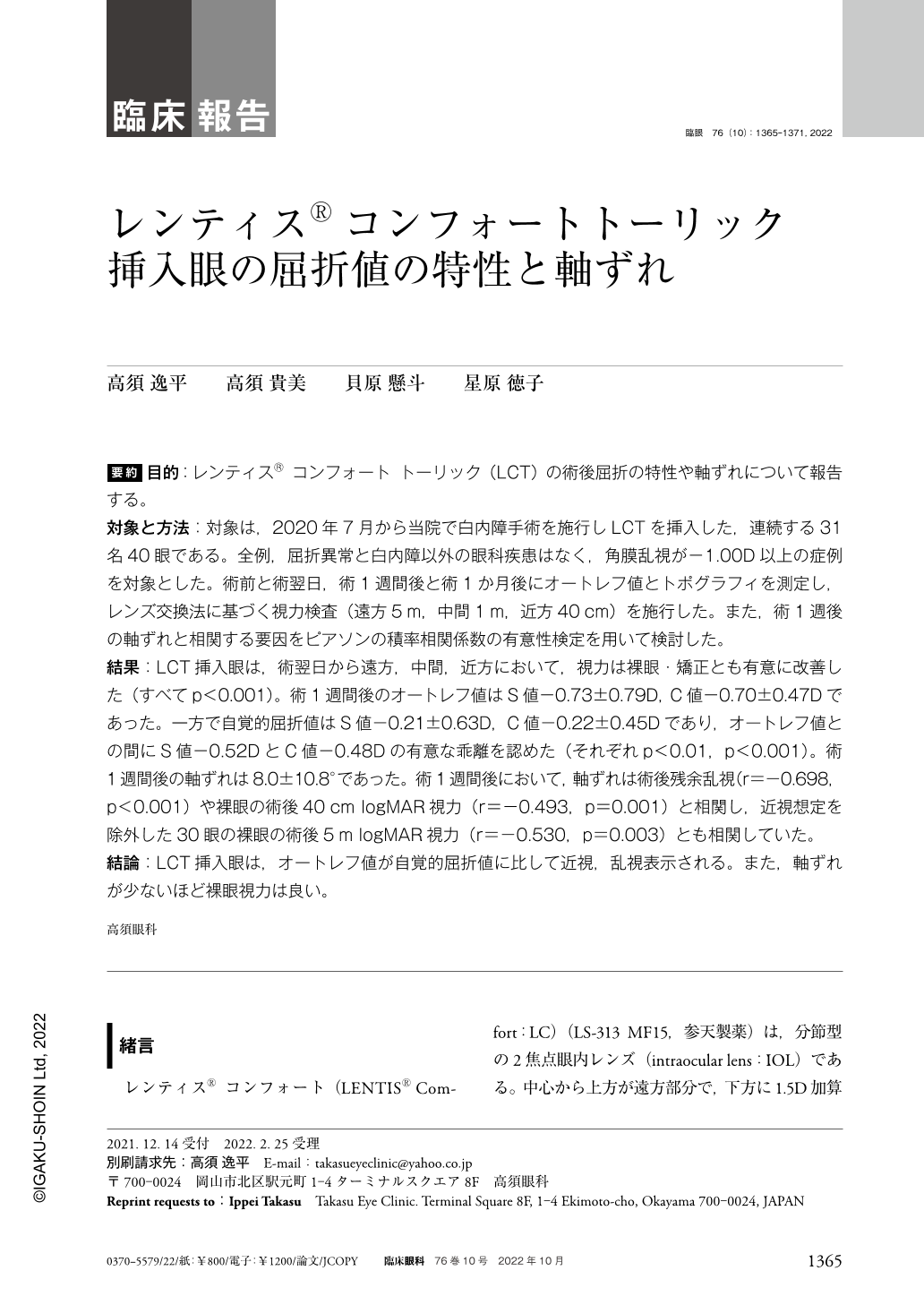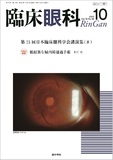Japanese
English
- 有料閲覧
- Abstract 文献概要
- 1ページ目 Look Inside
- 参考文献 Reference
要約 目的:レンティス® コンフォート トーリック(LCT)の術後屈折の特性や軸ずれについて報告する。
対象と方法:対象は,2020年7月から当院で白内障手術を施行しLCTを挿入した,連続する31名40眼である。全例,屈折異常と白内障以外の眼科疾患はなく,角膜乱視が−1.00D以上の症例を対象とした。術前と術翌日,術1週間後と術1か月後にオートレフ値とトポグラフィを測定し,レンズ交換法に基づく視力検査(遠方5m,中間1m,近方40cm)を施行した。また,術1週後の軸ずれと相関する要因をピアソンの積率相関係数の有意性検定を用いて検討した。
結果:LCT挿入眼は,術翌日から遠方,中間,近方において,視力は裸眼・矯正とも有意に改善した(すべてp<0.001)。術1週間後のオートレフ値はS値−0.73±0.79D,C値−0.70±0.47Dであった。一方で自覚的屈折値はS値−0.21±0.63D,C値−0.22±0.45Dであり,オートレフ値との間にS値−0.52DとC値−0.48Dの有意な乖離を認めた(それぞれp<0.01,p<0.001)。術1週間後の軸ずれは8.0±10.8°であった。術1週間後において,軸ずれは術後残余乱視(r=−0.698,p<0.001)や裸眼の術後40cm logMAR視力(r=−0.493,p=0.001)と相関し,近視想定を除外した30眼の裸眼の術後5m logMAR視力(r=−0.530,p=0.003)とも相関していた。
結論:LCT挿入眼は,オートレフ値が自覚的屈折値に比して近視,乱視表示される。また,軸ずれが少ないほど裸眼視力は良い。
Abstract Purpose:To report the characteristics of refraction and misalignment of axis in eyes implanted with LENTIS® Comfort Toric intraocular lens(LCT)(Santen Pharmaceutical Co., Ltd.).
Methods:Forty eyes of 31 cataract patients that showed corneal astigmatism higher than −1.0 diopter(D)were consecutively implanted with LCT from July 2020. None of these eyes showed ocular disorders without any cataract and refractive error observed prior to surgery. There was no intraoperative complication. The LCT was implanted in a capsular bag and its axis was adjusted to a steep meridian in all of the cases according to the corneal astigmatism. One day, one week, and one month postoperatively, refraction was measured using an auto-refractometer(TONOREF®Ⅲ, NIDEK Inc.), and topography(KR-1W®, Topcon Inc.)was performed to determine the axis misalignment. Simultaneously, the uncorrected and corrected visual acuities at 5-meter distant, 1-meter intermediate and 40-centimeter near were measured on the basis of the subjective refractive values. Factors correlated with the axis misalignment were analyzed via Pearson correlation coefficient analysis one week after surgery.
Results:Mean uncorrected visual acuity(VA)and mean corrected VA significantly improved in all ranges from far to near postoperatively(p<0.001, t-test). The refractive values, as measured using the auto-refractometer were as follows:sphere(S)−0.73±0.79D and cylinder(C)−0.70±0.47D, and S−0.21±0.63D and C−0.22±0.45D subjectively 1 week after surgery. There were significant discrepancies with regard to S−0.52D(p<0.01 t-test)and C−0.48D(p<0.001 t-test)between the refractive values obtained using the auto refractometer and the subjective refractive values of the eyes implanted with LCT. The axis misalignment was 8.0±10.8° one week after surgery. The axis misalignment was correlated with residual astigmatism(r=−0.698, p<0.001), uncorrected near VA(r=−0.493, p=0.001), and uncorrected distant VA(r=−0.530, p<0.01)one week postoperatively.
Conclusion:The refractive values measured using the auto refractometer were indicated higher myopic astigmatism than the subjective refractive values in eyes implanted with LCT. The lesser the axis misalignment, the better was the uncorrected VA after surgery.

Copyright © 2022, Igaku-Shoin Ltd. All rights reserved.


